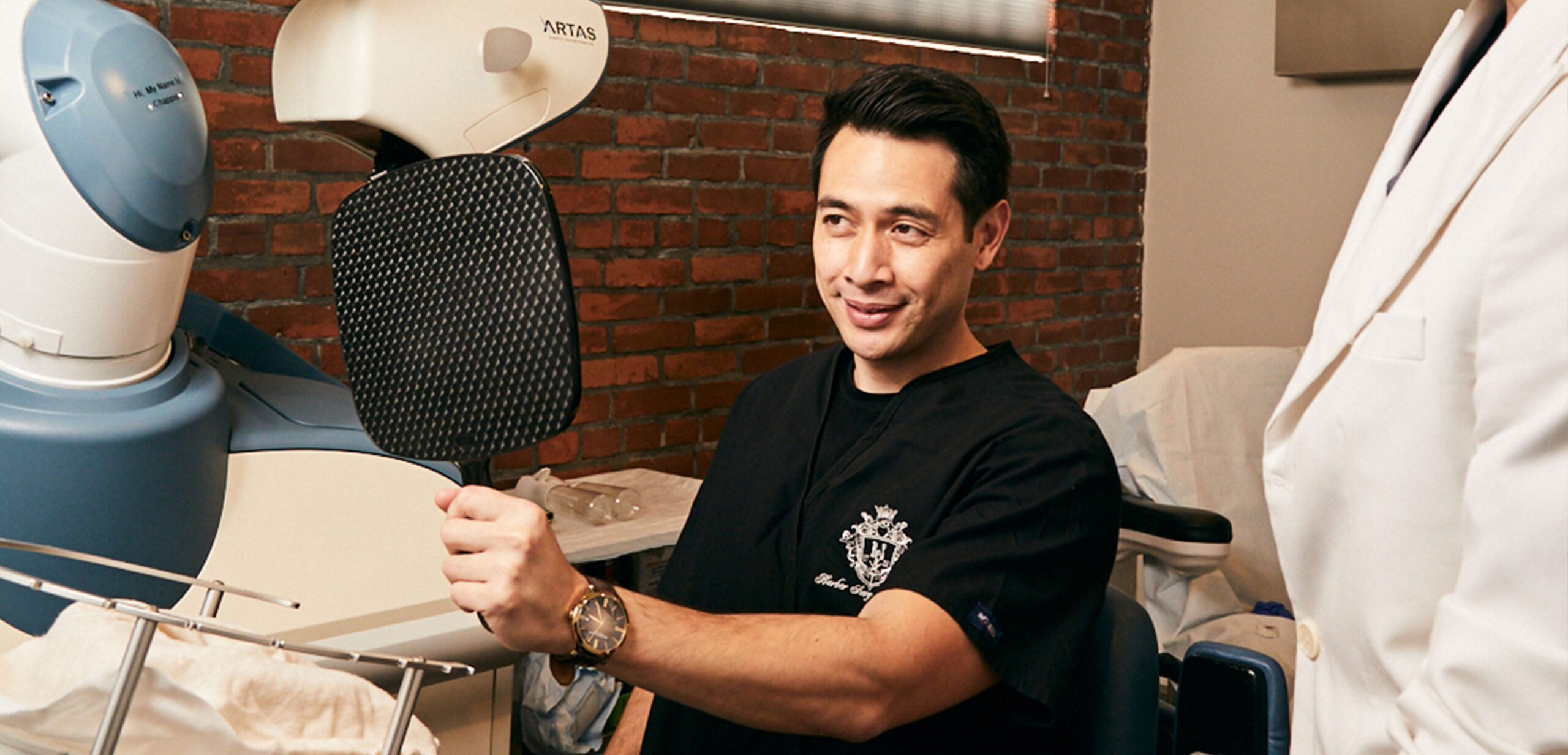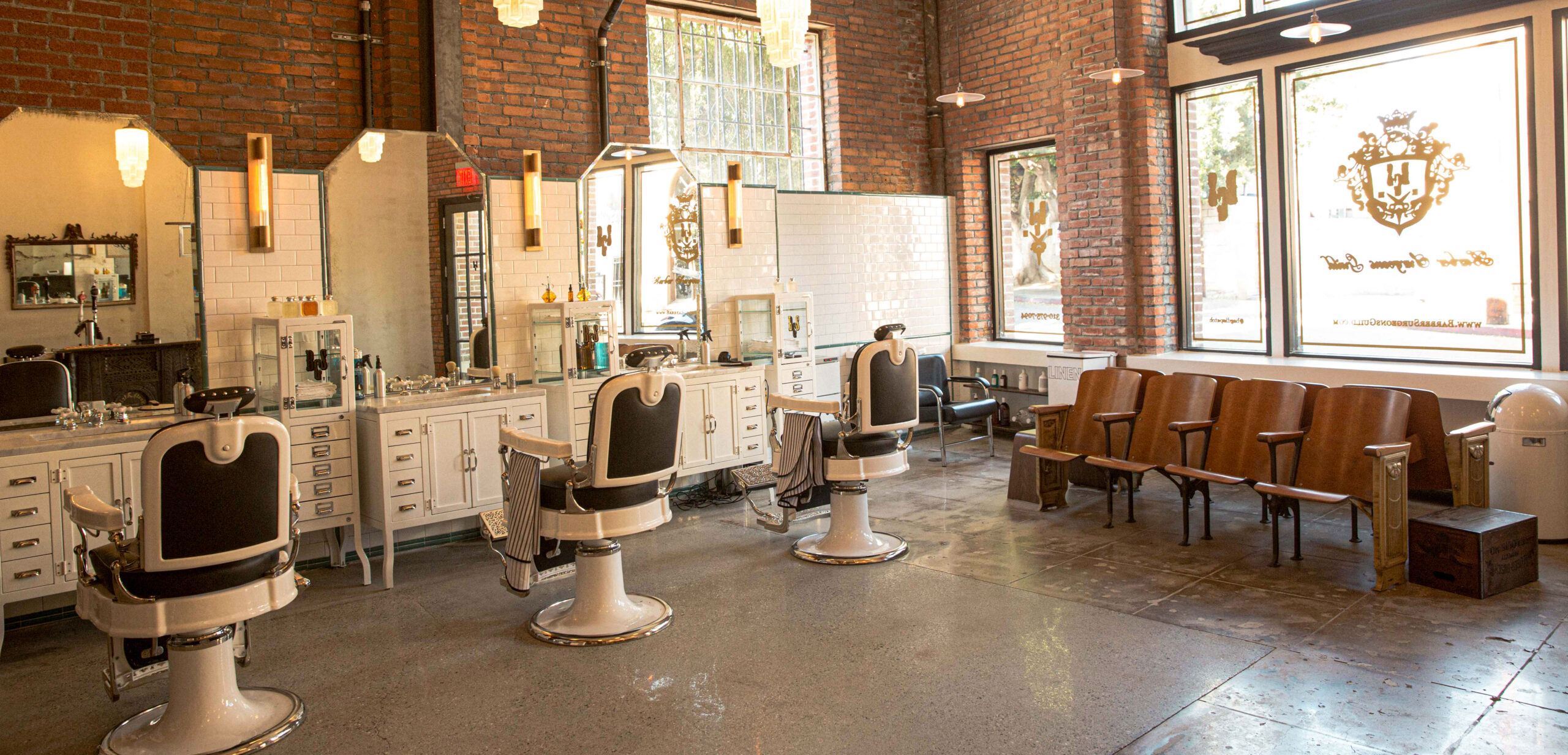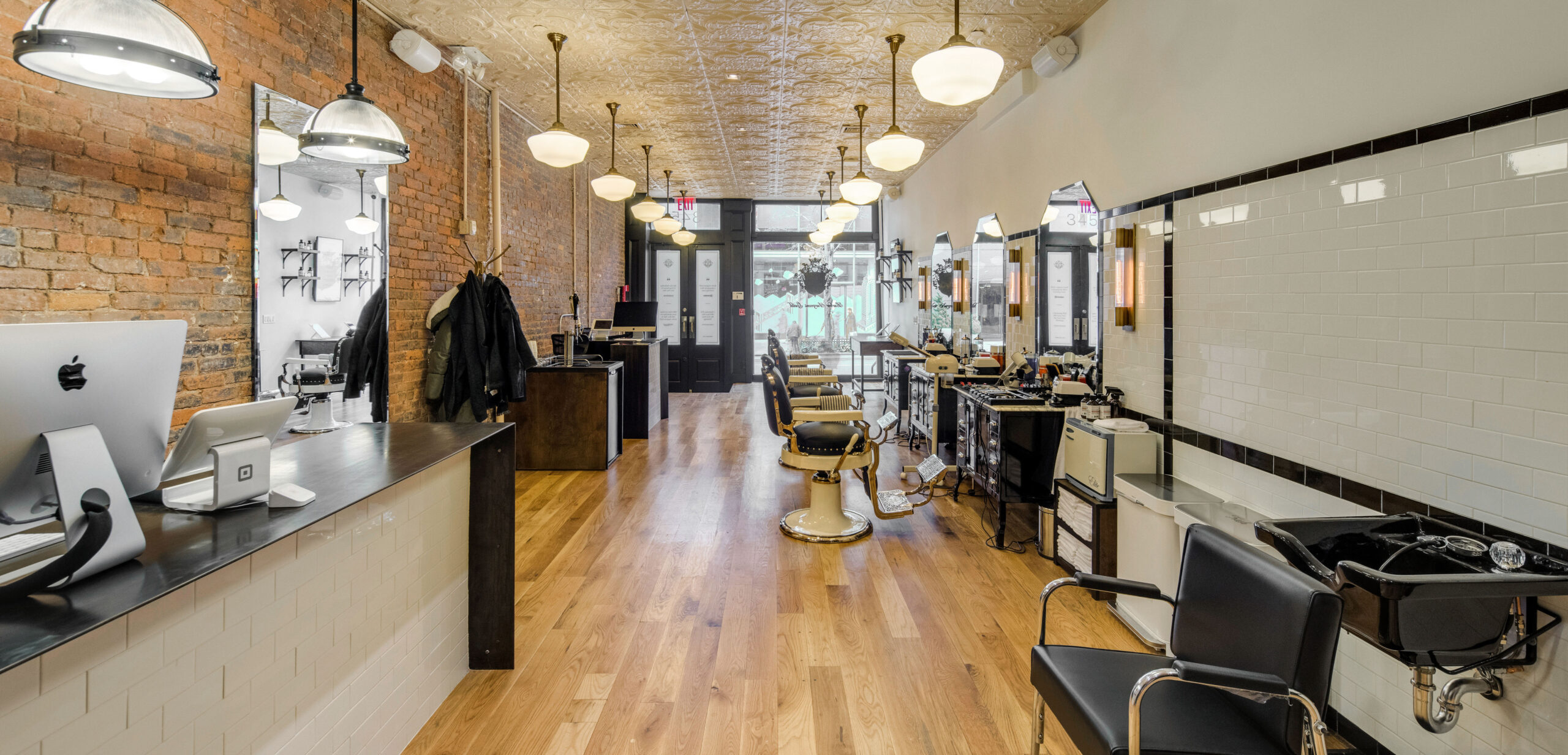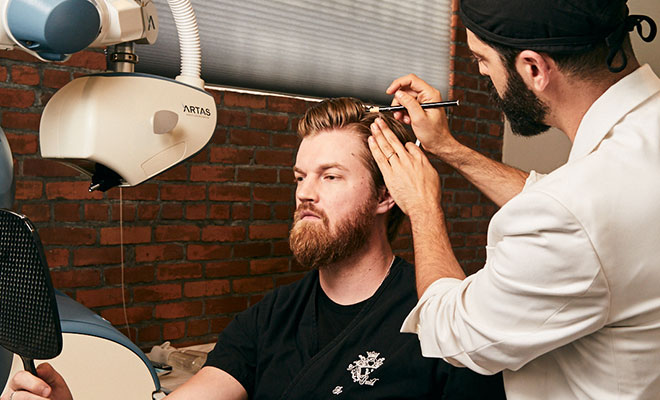
The cost of hair restoration will vary greatly depending on how much hair needs to be restored, the type of procedure being performed, and the overall quality of the treatment facility. Though they are strongly not recommended, budget hair restoration procedures are often available overseas in countries like Turkey, and cheaper procedures in the U.S. can be found by opting for FUT over FUE. In general manual FUE is less expensive than robotic FUE. However at Barber Surgeons Guild®, we competitively price our robotic FUE alongside market manual FUE prices. On average, hair restoration costs between $5,000 and $20,000, with the majority of cases being somewhere in the middle. Most hair restoration centers will quote by the graft, however at BSG we charge by the area which gives us the flexibility to obtain the right number of grafts based on your needs. Learn more about our pricing structure.
1. BSG Doesn’t Charge By The Graft

Rather than charging by the graft like other clinics, BSG approaches pricing differently. Our surgical treatment plans are more focused on aligning with patients on results and restoring hair style. We’ve found that holding strictly to some predetermined graft number is less helpful to our patients. While our approach to pricing is highly uncommon in the world of hair restoration, it has been our approach since BSG first opened. For us, it’s the difference between hearing our patients say, “My hair looks great” versus, “My 2,000 grafts look great”. There are a number of factors that determine how many grafts a patient will need to achieve desired results, and this number is never so neatly rounded. When patients sign up for a fixed number of grafts, they will either not get enough hair, or, possibly worse, their donor area will have been overharvested and their donor supply depleted unnecessarily. Overharvesting the donor area could prevent a patient from treating future hair loss with additional hair restoration.
On the day of the procedure, BSG hair restoration surgeons begin the day with planning, which involves mapping out the areas where hair will be transplanted. The planning process is very detailed, and the doctor and patient (along with a partner, if desired) will work together until a fully agreed upon plan is chosen. After planning, the doctor will make the recipient sites for the new grafts based on the final approved drawings. From the drawings, the doctor will determine the number of recipient sites to be made and the corresponding number of grafts required. Drawing a plan the day of surgery ensures we will never over- or under-harvest. We determine exactly what is needed and then harvest the grafts accordingly.
Out of body time of grafts can impact graft viability. Since our surgeons make recipient sites before harvesting grafts, we’re able to minimize out of body time of the grafts. Upon harvesting, grafts can be placed quickly since the recipient sites have already been made. In fact, our surgeons typically place grafts at the same time as they are harvested, a technique that BSG founder, Dr. Rome, presented at a major hair restoration conference.
Regarding grafts generally, there is poor consensus into what is considered a graft–is it a hair? Is it a follicular unit? etc. Often, larger unit grafts are trimmed into more than one graft when single haired grafts are needed to build up a hairline. While this is an appropriate use of graft duplication, some clinics will use this practice to simply increase graft counts, a practice we believe is unethical as it leads to less hair transplanted for the sake of meeting a predetermined number of grafts. In addition, this technique also poses unnecessary risk to the grafts, as they are undergoing dissection without cause. At BSG, we never cut down grafts beyond the need to get enough singles for the hairline. In fact, in the case of fine hair with lower numbers of hairs per follicular unit, we will often create larger grafts from smaller ones. This practice effectively decreases our graft count, but allows us to double the number of hairs transplanted. For example, if an individual had all two-haired follicular units and had 1,000 units harvested, cutting each unit into two grafts would yield, a total of 2,000 grafts to be placed. If none of these units were cut, 1,000 grafts would be placed. If each of these grafts were grouped together to create four-haired grafts, 500 grafts would be placed. In each example, the same 2,000 hairs are placed, though the technical graft count varies wildly in each scenario (2,000 to 1,000 to 500). This is exactly why charging by the graft can be confusing and misleading.
Barber Surgeons Guild® is fully committed to achieving the best possible results, so we take care to harvest the appropriate number of grafts needed to achieve a desired outcome. By structuring costs this way, we have no motivation to under-harvest.
We aim to educate on all the options you may benefit from to prevent future hair loss, as well as options to make improvements to your hair.
How Much Does 2000 To 5000 Grafts Cover?
The amount of area covered by hair grafts varies based on a number of factors. See the questions below to better understand the factors hair restoration surgeons must consider when determining how many grafts are needed for a patient.
- How much hair is present?
The density of existing hair is a primary factor in determining how many grafts will be required to restore the look of fuller hair. 2500 grafts can cover up a full head if there is hair everywhere, but not great density anywhere. On the other hand, without any hair present at all, 2500 grafts would cover just half a head. - Are the hair follicles fine or thick?
Fine hair requires more grafts to cover the same area than thick hair does. - Is the hair straight or curly?
Straight hair requires more grafts to fill an area than curly hair which takes up more volume. - What is the average number of hairs per follicular unit?
There is great variation in numbers of hairs per follicle unit which is mostly determined by race. For example, while Asian hair has far fewer hairs/unit than Caucasian hair, Asian hair follicles are usually thicker than caucasian hair follicles. The number of hairs/unit will also determine how much coverage is achieved with a certain number of hair grafts.
It is worth mentioning that transplanting in excess of 30-40 follicular units per square centimeter will lead to decreased graft growth due to limited blood supply. It is much safer to do two 2000 graft procedures over 2 years than one 4000 graft procedure where many of the grafts will not take. In the USA, it is rare that any doctor will perform a procedure over 3000 grafts for this reason. Be wary of anyone suggesting 3000+ grafts, as they are either talking about hairs and not grafts or they are okay with the risk of graft failure.

BENEFITS OF FUE WITH BSG
- No linear scarring
- Quick and relatively painless recovery
- Minimally invasive, no scalpel or sutures
- Excellent harvest accuracy with Robotic FUE
- Natural results
- All follow ups included along with maintenance optimization
Speak with our renowned physicians.
We Are Taking Robotic Hair Restoration To The Next Level
Barber Surgeons Guild® has been ranked as an ARTAS® Center of Clinical Excellence. BSG is so respected, in fact, that it serves as a training center for other doctors who learn how to excel with ARTAS® procedures. We do not use dated methods of hair restoration that other clinics still offer because we know our clients deserve the best. This is why all our procedures are done with the highest tech form of follicular unit extraction (FUE).
Unlike procedures performed by most other hair restoration providers, procedures involve robotically harvesting hairs with ultimate precision. This is done through the latest 9x robotic software version, and it ensures you have the best possible outcome. Our all-inclusive “Fill-the-Area” pricing also includes therapies such as PRP—at no additional cost—to give you the head of hair to make you feel like yourself again.
We Are Taking Robotic Hair Restoration To The Next Level
Barber Surgeons Guild® has been ranked as an ARTAS® Center of Clinical Excellence. BSG is so respected, in fact, that it serves as a training center for other doctors who learn how to excel with ARTAS® procedures. We do not use dated methods of hair restoration that other clinics still offer because we know our clients deserve the best. This is why all our procedures are done with the highest tech form of follicular unit extraction (FUE).
Unlike procedures performed by most other hair restoration providers, procedures involve robotically harvesting hairs with ultimate precision. This is done through the latest 9x robotic software version, and it ensures you have the best possible outcome. Our all-inclusive “Fill-the-Area” pricing also includes therapies such as PRP—at no additional cost—to give you the head of hair to make you feel like yourself again.
2. How Much Is A Hair Transplant In Los Angeles?

The cost of hair restoration will vary greatly depending on how much hair needs to be restored, the type of procedure being performed, and where you go. Budget hair restoration procedures can be obtained by traveling to Turkey, and cheaper procedures in the USA can be obtained by opting for FUT over FUE. In general, manual FUE is less expensive than robotic FUE, however, at Barber Surgeons Guild®, we competitively price our robotic FUE alongside market manual FUE prices. On average, hair restoration in Los Angeles costs between $7,500 and $20,000, with the majority of cases being somewhere in the middle. Most hair restoration centers will quote by the graft, however at BSG we charge by the area which gives us the flexibility to obtain the right number of grafts based on your needs. Learn more about our Lost Angeles Outpost.
3. How Much Is A Hair Transplant In New York?

The cost of hair restoration will vary greatly depending on how much hair needs to be restored, the type of procedure being performed, and where you go. Budget hair restoration procedures can be obtained by traveling to Turkey, and cheaper procedures in the USA can be obtained by opting for FUT over FUE. In general manual FUE is less expensive than robotic FUE, however at Barber Surgeons Guild®, we competitively price our robotic FUE alongside market manual FUE prices. On average, hair restoration costs between $8,000 and $20,000, with the majority of cases being somewhere in the middle. Most hair restoration centers will quote by the graft, however at BSG we charge by the area which gives us the flexibility to obtain the right number of grafts based on your needs. Learn more about our New York Outpost.

BENEFITS OF ROBOTIC HAIR RESTORATION WITH BSG
- Advanced AI technology
- Eliminates human error/fatigue during procedure
- Protects existing hair follicles
- No linear scarring
- Quick and relatively painless recovery
- Minimally invasive, no scalpel or sutures
- Excellent harvest accuracy with Robotic FUE
- Natural results
- All follow ups included along with maintenance optimization
Speak with our renowned physicians.
Cutting-Edge Solutions
Our clients expect only the best and most advanced hair restoration procedures when they visit us. You shouldn’t have to suffer the downfalls of hair loss. Luckily, our solutions mean that you don’t have to. It’s possible to achieve natural results while avoiding the linear scarring and downtime of dated procedures that many clinics still provide.
Real Clients. Real Results.
Josh, Hair Restoration Client
Zach, The Try Guys
Mike, Ladylike


Located In Los Angeles & New York Specializing In Robotic Hair Restoration
LA Outpost
WEST HOLLYWOOD
805 Larrabee St.
Los Angeles, CA 90069
Hours of Operation
Hair Restoration & Maintenance
Monday – Friday 9:00 AM – 5:00 PM
Barbershop
Monday – Saturday 10:00 AM – 7:00 PM
Sunday 10:00 AM – 6:00 PM
NYC Outpost
MIDTOWN
240 W 37th St., 5th Floor
New York, NY 10018
Hours of Operation
Hair Restoration & Maintenance
Monday – Friday 9:00 AM – 5:00 PM
Barbershop
Monday – Saturday 10:00 AM – 8:00 PM
Sunday 10:00 AM – 6:00 PM
